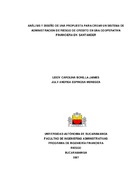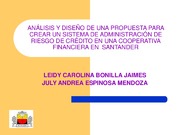Mostrar el registro sencillo del ítem
Análisis y diseño de una propuesta para crear un sistema de administración de riesgo de crédito en una cooperativa financiera en Santander
| dc.contributor.advisor | Carvajal Herrera, Luz Helena | |
| dc.contributor.author | Bonilla Jaimes, Leidy Carolina | |
| dc.contributor.author | Espinosa Mendoza, July Andrea | |
| dc.coverage.spatial | Santander (Colombia) | spa |
| dc.coverage.temporal | 2007 | spa |
| dc.date.accessioned | 2021-08-24T14:05:23Z | |
| dc.date.available | 2021-08-24T14:05:23Z | |
| dc.date.issued | 2007 | |
| dc.identifier.uri | http://hdl.handle.net/20.500.12749/13974 | |
| dc.description.abstract | En términos generales, se puede deducir un desenvolvimiento financiero muy acorde a las políticas de estabilidad y crecimiento por parte de la empresa, contando con resultados muy positivos en cuanto rentabilidad se refiere, endeudamiento y comportamiento financiero general. Este análisis demostró un panorama eficiente en la operación de SANDERCOOP LTDA frente al sector financiero. Con el fin de desarrollar un buen manejo de la administración del riesgo, se planteó un proceso de gestión de riesgo, donde se partió de un modelo econométrico y se finalizo con un SCORING. Por medio del modelo econométrico de probabilidad se pudo ver como las variables que finalmente aumentan el riesgo en el crédito son: monto del crédito, personas a cargo, y el plazo del crédito. Por el lado de aumentar el riesgo aparecen las variables: edad, codeudor, sector publico, sector salud, y cargo. Finalmente, por medio del Scoring se pudo deducir el puntaje de un cliente, donde de acuerdo a las políticas de financiamiento de la empresa se determino el intervalo para aceptar el crédito de forma inmediata, solicitar un requisito adicional y la aceptación del mismo. A diferencia del logit, el scoring incorporo el total de las variables independientes, para evitar la pérdida de información por parte del cliente. Sin embargo, esta diferencia no altero los resultados finales en la validación de ambos modelos en el momento de reemplazar los datos del cliente a validar. | spa |
| dc.description.tableofcontents | INTRODUCCIÓN 10 OBJETIVO GENERAL 11 OBJETIVOS ESPECIFICOS 11 1. ASPECTOS FUNDAMENTALES DEL SARC 12 2. ASPECTOS INTERNOS DE LA COOPERATIVA 15 2.1 MISIÓN 15 2.2 VISION 15 2.3 MERCADO OBJETIVO 15 2.4 RECURSO HUMANO Y TECNOLÓGICO 16 2.5 LINEAS DE CRÉDITO 16 2.5.1 Por Libranza 16 2.5.2 Personal 17 2.6 POLITICAS DE SERVICIO DE CRÉDITO 17 2.6.1 Por línea de crédito. 17 3. OTORGAMIENTO DE CREDITO 22 3.1 FLUJOGRAMA ESTUDIO Y APROBACION DE CREDITO 22 4. FASES DE CREDITO Y CARTERA 23 4.1 PRIMERA FASE: SERVICION AL CLIENTE 23 4.2 SEGUNDA FASE: RECEPCIÓN Y RADICACIÓN DE DOCUMENTOS 24 4.3 TERCERA FASE: ESTUDIO DEL CRÉDITO 24 4.4 CUARTA FASE: APROBACIÓN DEL CRÉDITO 24 4.5 QUINTA FASE: LEGALIZACIÓN DE DOCUMENTOS 25 4.6 SEXTA FASE: DESEMBOLSO DEL CRÉDITO 25 4.7 SÉPTIMA FASE: SEGUIMIENTO DE CARTERA 25 4.8 OCTAVA FASE: RECUPERACION DE CARTERA 25 5. PROPUESTA DE APLICACIÓN EN LA COOPERATIVA TOMANDO COMO REFERENCIA EL SARC 26 6. ESTADISTICAS DE CARTERA 28 6.1 ESTADISTICAS DE ASOCIADOS 31 6.2 PROVISIONES 32 6.3 INDICADORES FINANCIEROS 33 6.4 FACTORES DE RIESGO DE CRÉDITO 37 6.4.1 Escala de medición. 38 7. DESARROLLO DEL MODELO 40 7.1 POLITICAS PARA CLASIFICAR LA VARIABLE DEPENDIENTE 40 7.2 VARIABLES INDEPENDIENTES. 41 7.2.1 Monto del crédito. 41 7.2.2 Plazo del crédito. 42 7.2.3 Edad. 42 7.2.4 Codeudores. 43 7.2.5 Sector publico. 43 7.2.6. Sector salud. 44 7.2.7 Valor cuota. 44 7.2.8 Personas a cargo. 45 7.2.9 Saldo Capital. 46 7.2.10 Estrato. 46 7.2.11 Estado civil. 47 7.2.12 Cargo. 47 7.2.13 Sueldo. 48 7.2.14 Antigüedad. 48 7.2.15 Sexo. 49 7.2.16 Aportes. 50 7.2.17 Tasa. 50 7.2.18 Línea. 51 7.2.19 Créditos solicitados. 51 8. MODELO LOGIT. 53 8.1 DEFINICIÓN 53 8.1.1 Estadísticas de las variables en el Programa Eviews 4.1. 53 8.1.2 Modelo econométrico por medio del programa Eviews 4.1 56 8.1.3 Pruebas de significancia de los Bt.. 57 8.1.4 Problema de multicolinealidad. 62 8.1.5 Prueba de significancia global. 65 8.1.6 Pruebas deficiencia del modelo,.Cuenta R. 65 8.1.7 Interpretación de los coeficientes. 67 9. SCORING 71 10. VALIDACION DEL MODELO “MAC” 77 11. MANUAL DE OTORGAMIENTO DE CRÉDITO DE LA EMPRESA. 81 CONCLUSIONES 82 BIBLIOGRAFÍA 84 | spa |
| dc.format.mimetype | application/pdf | spa |
| dc.language.iso | spa | spa |
| dc.rights.uri | http://creativecommons.org/licenses/by-nc-nd/2.5/co/ | * |
| dc.title | Análisis y diseño de una propuesta para crear un sistema de administración de riesgo de crédito en una cooperativa financiera en Santander | spa |
| dc.title.translated | Analysis and design of a proposal to create a credit risk management system in a financial cooperative in Santander | spa |
| dc.degree.name | Ingeniero financiero | spa |
| dc.publisher.grantor | Universidad Autónoma de Bucaramanga UNAB | spa |
| dc.rights.local | Abierto (Texto Completo) | spa |
| dc.publisher.faculty | Facultad Economía y Negocios | spa |
| dc.publisher.program | Pregrado Ingeniería Financiera | spa |
| dc.description.degreelevel | Pregrado | spa |
| dc.type.driver | info:eu-repo/semantics/bachelorThesis | |
| dc.type.local | Trabajo de Grado | spa |
| dc.type.coar | http://purl.org/coar/resource_type/c_7a1f | |
| dc.subject.keywords | Financial engineering | spa |
| dc.subject.keywords | Financial analysis | spa |
| dc.subject.keywords | Financial managenment | spa |
| dc.subject.keywords | Investigation | spa |
| dc.subject.keywords | Delinquent portfolio | spa |
| dc.subject.keywords | Econometric model | spa |
| dc.subject.keywords | Scoring | spa |
| dc.subject.keywords | Validation | spa |
| dc.subject.keywords | MAC | spa |
| dc.identifier.instname | instname:Universidad Autónoma de Bucaramanga - UNAB | spa |
| dc.identifier.reponame | reponame:Repositorio Institucional UNAB | spa |
| dc.type.hasversion | info:eu-repo/semantics/acceptedVersion | |
| dc.rights.accessrights | info:eu-repo/semantics/openAccess | spa |
| dc.rights.accessrights | http://purl.org/coar/access_right/c_abf2 | spa |
| dc.relation.references | 1. DE LARA HARO, Alfonso. Medición y control de riesgos financieros. Editorial Limusa. Mexico 2002. | spa |
| dc.relation.references | 2. ESTEBAN ARIZA, Nixon Arley y MENDEZ GUERRERO, William Julián. Análisis del Riesgo Crediticio en el sector cooperativo especialmente en COOPCENTRAL. Facultad Ingeniería financiera. UNAB 2005. | spa |
| dc.relation.references | 3. HERNANDEZ, Sampieri. Metodología de la Investigación. Editorial McGraw Hill. México 2003. | spa |
| dc.relation.references | 4. MADURA, Jeff. Mercados e instituciones financieros. Internacional Thomson Editores S.A. 2001 | spa |
| dc.relation.references | 5. MEZA LEÓN, Emy Carolina. Modelo para la gestión del riesgo de la cartera de la cooperativa Santandereana de transportadores Copetran. Facultad Ingeniería financiera. UNAB 2005. | spa |
| dc.relation.references | 6. PELAYO MILLAN, Rodolfo. Revista Cooperante. Diciembre 2005-Enero 2006. P.2 | spa |
| dc.relation.references | 7. VILARIÑO SANZ, Angel. Turbulencias financieras y Riesgos de Mercado. Editorial Prentice Hall. Madrid 2001. | spa |
| dc.relation.references | 8. DAMODAR N. Gujarati, Econometria, Mc Graw Hill, cuarta edición, 2003. | spa |
| dc.relation.references | 9. ELIZONDO Alan, Medición integral del riesgo de crédito, Limusa Noriega Editores, 2003. | spa |
| dc.relation.references | 10. WESTON FED, Copeland Thomas, Manual de Administración Financiera, Tomo 2, McGraw-Hill, 2000. | spa |
| dc.relation.references | CARRASCAL ARRANZ, Ursicinio Análisis Econométrico con Eviews, cuarta edición, 2003. | spa |
| dc.relation.references | 1. BERMUDEZ SALGAR, Jorge. El Sarc Un Cambio Cultural. Julio de 2003. www.superfinanciera.gov.co/ComunicadosyPublicaciones/80web/archivos/JorgeBermudez.pdf | spa |
| dc.relation.references | 2. DE LA FUENTE, Maria de Lourdes. La administración integral de Riesgos financieros. www.uia.mx/licenciaturas/dpt_economia/economia/pdf/delaFuente.PDF - | spa |
| dc.relation.references | 3. GALICIA ROMERO, Martha. Nuevos enfoques de riesgo de crédito. 2003. www.riesgofinanciero.com/071403RiesgoCredito.pdf | spa |
| dc.relation.references | 4. SILVA, Rodrigo. Elementos de Riesgo www.actuarios.org.co/ElemRiesgo.pdf | spa |
| dc.relation.references | 5. ZORILLA SALGADOR, Juan Pablo. La administración de riesgos. Xalapa. www.gestiopolis.com | spa |
| dc.relation.references | 6. clain.asobancaria.com/EventManagerServlet?idioma=1&accion=mostrarPrograma - 13k | spa |
| dc.relation.references | 7. www.superfinanciera.gov.co | spa |
| dc.relation.references | 8. www.ultrabursatiles.com/web/archivos/archivo19.pdf | spa |
| dc.contributor.cvlac | Carvajal Herrera, Luz Helena [0000381381] | spa |
| dc.contributor.orcid | Carvajal Herrera, Luz Helena [0000-0003-4399-9953] | spa |
| dc.contributor.researchgate | Carvajal Herrera, Luz Helena [Luz_Carvajal_Herrera] | |
| dc.subject.lemb | Análisis financiero | spa |
| dc.subject.lemb | Ingeniería financiera | spa |
| dc.subject.lemb | Gestión financiera | spa |
| dc.subject.lemb | Investigación | spa |
| dc.identifier.repourl | repourl:https://repository.unab.edu.co | spa |
| dc.description.abstractenglish | Generally speaking, one can infer an unfolding financial well attuned to the political stability and growth by the company, with very positive results in terms of profitability concerns, indebtedness and financial behavior. This analysis showed a picture efficient operation SANDERCOOP LTDA front of the financial sector. In order to develop a good handling risk management, it posed a risk management process, which started from an econometric model and ended with a SCORING. Through the econometric model of probability could see how the variables that ultimately increase the risk in the credit are: amount of the credit, dependents, and the period of credit. On the side appear to increase the risk variables: age, codeudor, public sector, health sector, and charge. Finally, through Scoring could deduct the score of a client, where according to the policies on financing the company determines the interval to accept the credit immediately, requesting an additional requirement and acceptance of it. Unlike the logit, scoring incorporates all the independent variables, to prevent loss of information by the client. However, this difference was not altered the final results in the validation of both models at the time of replacing the customer data to validate. | spa |
| dc.subject.proposal | Cartera morosa | spa |
| dc.subject.proposal | Modelo econométrico | spa |
| dc.subject.proposal | Scoring | spa |
| dc.subject.proposal | Validación | spa |
| dc.subject.proposal | MAC | spa |
| dc.type.redcol | http://purl.org/redcol/resource_type/TP | |
| dc.rights.creativecommons | Atribución-NoComercial-SinDerivadas 2.5 Colombia | * |
| dc.coverage.campus | UNAB Campus Bucaramanga | spa |
| dc.description.learningmodality | Modalidad Presencial | spa |
| dc.contributor.linkedin | Carvajal Herrera, Luz Helena [luz-helena-carvajal-herrera-73b04a76/] |
Ficheros en el ítem
Este ítem aparece en la(s) siguiente(s) colección(ones)
-
Ingeniería Financiera [547]



